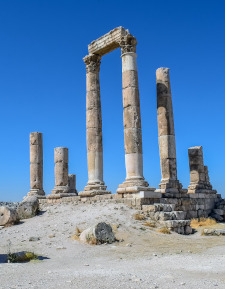Context
I. Introduction

I find the discussion interesting when a fellow Christian touts an interpretation of a bible verse that has little or no relation to the historic, economic, political or cultural context of the first century CE. Such background clarifies and gives insight to an obscure phrase. Consider Matthew 19:12c about ";...those who make themselves eunuchs for the Kingdom of heaven."; Those who lack the cultural context of Matthew's Semitic hyperbole might scratch their heads and ask, ";Really?";
Of course, context does matter, especially when the subject of the New Testament arises. If we know the backgrounds of both pagan and Jewish societies, including their intersection, we can more easily navigate some of the seemingly inscrutable passages in the Christian Scriptures. In fact, such knowledge deepens our appreciation of the narratives, the theology and the images we find in the founding documents of the Christian faith.
So, let us consider the context of the first century CE.
A. Greco-Roman Context
In the first section, we'll investigate Mediterranean ancient cultures in general, then narrow our focus upon the historical clash and integration of Hellenic influences into the Roman dominated world. We'll consider 1) the geography and infrastructure of the Empire, 2) the locus of social, economic and political power in the cities and 3) the place of religious practice and philosophic thought on the general populace. Finally, we'll place the nascent Jesus movement into the context.
B. Jewish Context
Much of Judaism in the first century CE was formed by outside forces. From the Babylonian Exile to the rise of Alexander and the Hellenistic dynasties in Syria and Egypt to the conquest of Palestine by Rome, Jews were not their own masters. Yet, they flourished in the Empire, adapting to the dominate Hellenistic culture and exerting both economic and social influence. While they splintered into various groups, they maintained a common world view, based upon practices outlined in their written Law and expounded in their prophetic and wisdom literature. They stood unique in the ancient world as a ";people of the Book.";
C. Christian Context
A new faith grew out of the intersection of both Greco-Roman and Jewish worlds. We can view aspects that belief movement through the following windows:
1. Early Christian Spirituality
The Christian Scriptures explicated the faith of ";The Way"; but it also described how they practiced that faith. Catholic biblical scholar Luke Timothy Johnson gives us a peak into that practice based upon his phenomenological method of scholarship. Through his lens, we can see the early Church was a small but vibrant movement that grew at a surprising rate.
2. The Law and Love
How did a Jewish movement rooted in duty to the Law morph into a Gentile Church that set aside much of the Torah? Inspired by John P. Meier's ";A Marginal Jew, Volume IV: Law and Love,"; we'll investigate that change through the lens of the Great Commandment and the Decalogue. We'll try to answer the question: how did interpretations of the Law (";halakhah";) evolve as Jewish Christian leaders died out to be replaced by Gentiles?
3. Four Messianic Images
How did Jews envision their ";Anointed One?"; In his book ";The Scepter and the Star,"; scholar John J. Collins proposed four images that had currency in the first century CE. We'll review those images and see how early Christians applied them to Jesus of Nazareth.
Click on the links to the left to find out more.
